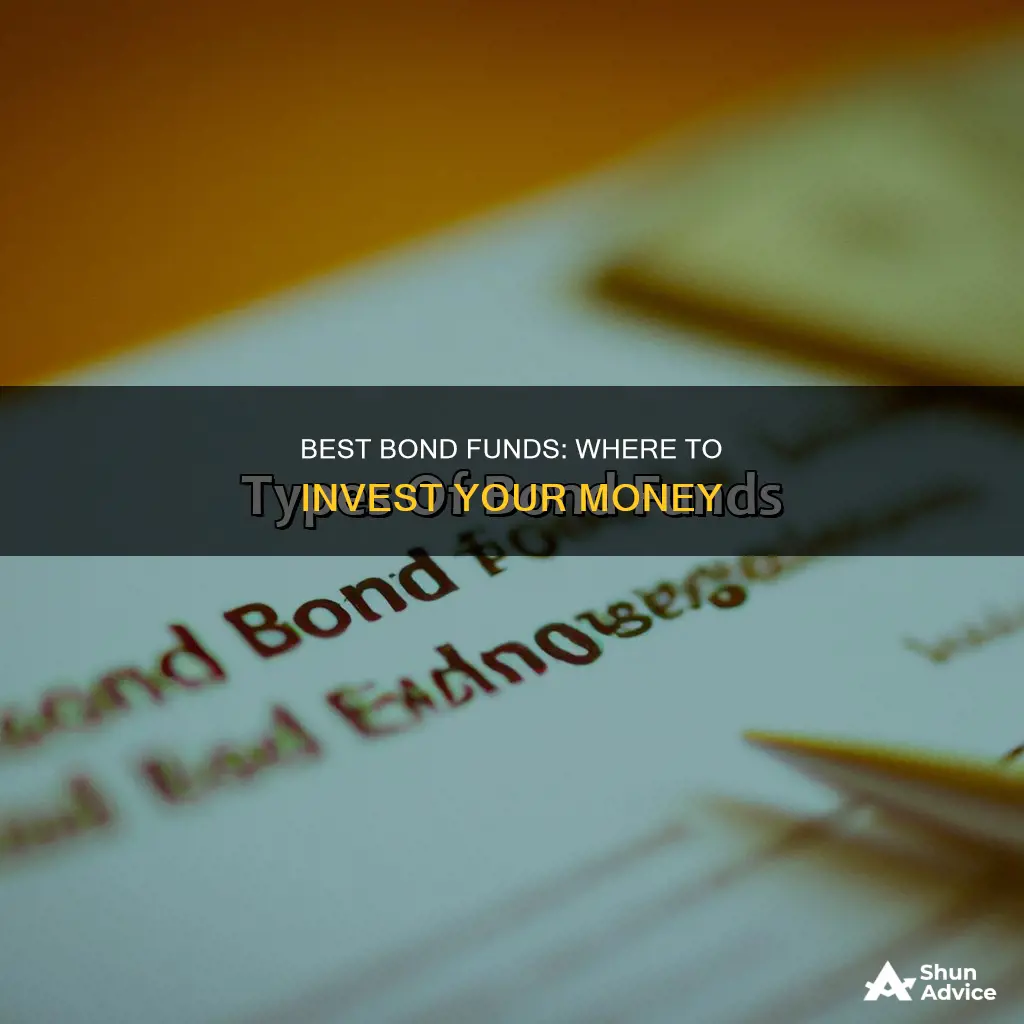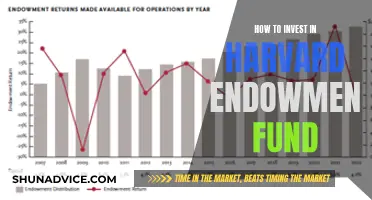
Bonds are getting a lot of attention from investors, and it's easy to see why. With inflation still high and interest rates at their highest levels since the 2007-09 financial crisis, bond yields are as high as they've been in years. But what are the best bond funds to invest in?
Well, that depends on your risk tolerance and desired income level. Federal I-Bonds or Treasury Inflation-Protected Securities (TIPS) are good options if you're looking to protect your money from inflation. On the other hand, if you want to earn a solid fixed-income payment with minimal risk, then investment-grade corporate bonds are a better bet.
When it comes to specific bond funds, there are a few standouts. The Vanguard Total Bond Market Index Fund Admiral Shares (VBTLX) is a popular choice for bond investors, offering diversified exposure to the fixed-income market. The PIMCO Total Return Fund (PTTAX) is another well-known option, with a long history of outperformance. And for those looking for a more stable option, the Vanguard Short-Term Treasury Fund Investor Shares (VFISX) invests in short-term and government bonds, two categories of assets with a high degree of certainty.
Of course, it's important to remember that there is no one-size-fits-all approach to investing in bond funds. The best option for you will depend on your individual financial goals and risk tolerance. So be sure to do your research and consider seeking advice from a qualified professional before investing.
| Characteristics | Values |
|---|---|
| Assets under management | $1.3 billion - $131.6 billion |
| Expense ratio | 0.025% - 0.91% |
| Investment type | Short-term, intermediate-term, long-term, government, corporate, municipal, etc. |
| Credit quality | Investment-grade, high-yield, etc. |
| Issuer | Vanguard, BlackRock, PIMCO, Dodge & Cox, iShares, SPDR, Fidelity, Columbia, etc. |
What You'll Learn

Best short-term bond funds
Short-term bond funds are a great option for investors looking for conservative investment options. These funds primarily invest in corporate and other investment-grade fixed-income securities with maturities of up to five years, making them less sensitive to interest rate changes. Here are some of the best short-term bond funds to consider:
SPDR Portfolio Short-Term Corporate Bond ETF (SPSB)
SPSB aims to track the Bloomberg U.S. 1-3 Year Corporate Bond Index, offering exposure to U.S. corporate bonds with maturities between one and three years. It has a low expense ratio of 0.04% and a yield of 4.33%. SPSB is a good option for investors seeking steady cash flow and moderate capital appreciation.
IShares 1-5 Year Investment Grade Corporate Bond ETF (IGSB)
The iShares fund tracks an investment-grade corporate bond index with maturities between one and five years. It includes bonds from well-known companies like Bank of America, JPMorgan Chase, and Microsoft. With an expense ratio of 0.04%, it offers a yield of 4.38%.
Schwab 1-5 Year Corporate Bond ETF (SCHJ)
SCHJ seeks to track the performance of an index measuring short-term U.S. corporate bonds with maturities between one and five years. It has a slightly lower expense ratio of 0.03% and provides a yield of 4.34%.
Vanguard Short-Term Bond ETF (BSV)
Vanguard's BSV ETF tracks a market-weighted bond index comprising investment-grade bonds with an average maturity of 1-5 years. The fund invests in government, high-quality corporate, and international dollar-denominated bonds. It has an expense ratio of 0.04% and a yield of 3.84%.
Fidelity Short-Term Bond Fund (FSHBX)
Fidelity's FSHBX fund aims to generate high current income while preserving capital. It invests primarily in investment-grade debt, with a dollar-weighted average maturity of three years or less. The fund has an expense ratio of 0.30% and a yield of 4.23%.
Other Notable Mentions
- Vanguard Short-Term Treasury Idx Admiral
- Schwab Short-Term US Treasury ETF™
- Vanguard Short-Term Treasury ETF
- PGIM Short Duration Mlt-Sect Bd ETF
- Baird Short-Term Bond BSBIX
- JPMorgan Limited Duration Bond ETF JPLD
- PGIM Short Duration Multi-Sector Bond Fund/ETF SDMZX PSDM
- IShares 0-5 Year Invmt Grade Corp Bd ETF
- IShares 1-5 Year invmt Grd Corp Bd ETF
- IShares ESG 1-5 Year USD Corp Bd ETF
- IShares Core 1-5 Year USD Bond ETF
- Vanguard Short-Term Corporate Bond ETF
- Vanguard Short-Term Bond ETF
- JPMorgan BetaBldrs 1-5 Yr US Aggt Bd ETF
- DFA Short-Duration Real Return Port
- Diamond Hill Short Dur Securitized Bd
- DoubleLine Low Duration Bond Fund
- Weitz Short Duration Income Fund
- Victory Short Term Bond
- Destinations Low Duration Fixed Inc Fund
- Payden Strategic Income Fund
- Fidelity® Series Short-Term Credit Fund
- Channel Short Duration Income Fund
- ALPS/Smith Short Duration Bond Fund
Putnam Short Duration Fund: A Safe Investment Bet?
You may want to see also

Best long-term bond funds
When considering the best long-term bond funds to invest in, it is important to note that long-term bond funds invest primarily in investment-grade U.S. fixed-income issues, including government, corporate, and securitized debt. Here are some of the best long-term bond funds to consider:
Mutual Funds
- Spirit of America Income Fd: This fund seeks to provide a high current income by investing in taxable municipal bonds.
- T. Rowe Price Instl Lng Dur Crdt Fund: This fund aims to provide high income by investing in a diversified portfolio of longer-duration corporate debt securities.
- PIMCO Long-Term Credit Bond Fund: This fund seeks total return, consistent with capital preservation and prudent investment management, by investing in a mix of high-quality and lower-rated credit securities.
- Vanguard Long Term Investment Grade Fund: This fund seeks to provide a high and sustainable level of current income by investing in a mix of high-quality and lower-rated credit securities.
- Sextant Bond Income Fund: This fund seeks current income by investing primarily in corporate and government bonds.
- SEI Long Duration Credit (SIIT) Fund: This fund aims to provide investment returns that correspond to high-quality bonds by investing in investment-grade securities.
Exchange-Traded Funds (ETFs)
- SPDR Portfolio Long-Term Corporate Bond ETF: This ETF seeks to provide investment results that correspond to the price and yield performance of the Bloomberg Long U.S. Corporate Index, focusing on long-term, investment-grade corporate debt.
- IShares 10+ Year Investment Grade Corporate Bond ETF (IGLB): This ETF provides exposure to the universe of investment-grade corporate bonds, tracking the ICE Bank of America 10+ Year US Corporate Index. It offers a high yield and a large number of holdings, reducing default risk.
- Vanguard Long-Term Corporate Bond ETF (VCLT): This ETF invests in high-quality corporate bonds with maturities between 10 and 25 years, tracking the Bloomberg U.S. 10+ Year Corporate Bond Index. It offers dependable cash flow and a well-diversified portfolio.
- Vanguard Long-Term Bond ETF (BLV): This ETF offers a broad portfolio of investment-grade bonds, tracking the Barclays U.S. Long Government/Credit Float Adjusted Index. It provides exposure to U.S. government debt, foreign issues, and corporate bonds, with a focus on long-term, investment-grade securities.
- IShares Core 10+ Year USD Bond ETF (ILTB): This ETF is a strong choice for a well-diversified investment portfolio, tracking the Bloomberg U.S. Universal 10+ Year Index. It offers exposure to corporate and government high-yield or investment-grade bonds with maturities of at least 10 years.
- FlexShares Credit-Scored U.S. Long Corporate Bond ETF (LKOR): This ETF focuses on long maturities, issuer quality, and value, investing primarily in investment-grade U.S. corporate bonds. It has a very long duration and provides international diversification.
It is important to conduct your own research and consult with a financial advisor to determine which long-term bond funds align with your investment goals and risk tolerance.
How to Choose the Right Managed Funds
You may want to see also

Best bond funds for retirement
When it comes to retirement planning, bond funds are a popular choice for investors due to their relatively lower volatility compared to stocks. Here are some of the best bond funds to consider for your retirement portfolio:
IShares Core U.S. Aggregate Bond ETF (AGG)
This fund seeks to provide broad exposure to the U.S. investment-grade bond market, with more than 70% of its assets invested in AAA-rated securities. It has a 5-year annualized return of 0.36% and a low expense ratio of 0.03%.
Vanguard Total Bond Market ETF (BND)
The Vanguard Total Bond Market ETF aims to track the performance of a broad, market-weighted bond index. It provides exposure to the U.S. taxable investment-grade bond market, with about two-thirds of its portfolio invested in U.S. government bonds. Its 5-year annualized return is 0.40%, and it has a low expense ratio of 0.03%.
Fidelity U.S. Bond Index Fund (FXNAX)
This fund seeks to track the total return of the debt securities in the Bloomberg Barclays U.S. Aggregate Bond Index. Typically, it invests at least 80% of its assets in securities included in the index. It has a 5-year annualized return of 0.38% and a low expense ratio of 0.025%.
Vanguard Short-Term Corporate Bond ETF (VCSH)
The Vanguard Short-Term Corporate Bond ETF primarily invests in high-quality, investment-grade corporate bonds, with a goal of providing current income and modest volatility. The fund maintains a dollar-weighted average maturity between one and five years. Its 5-year annualized return is 2.20%, and the expense ratio is 0.04%.
IShares Floating Rate Bond ETF (FLOT)
The iShares Floating Rate Bond ETF aims to track the performance of an index of U.S. investment-grade floating-rate bonds with maturities between one month and five years. Floating-rate bonds adjust their interest payments according to changes in interest rates, making them attractive during periods of rising rates. It has a 5-year annualized return of 2.91% and an expense ratio of 0.15%.
Fidelity Investment Grade Bond Fund (FBNDX)
This actively managed fund seeks to provide a high level of current income by investing primarily in investment-grade bonds. It typically invests at least 80% of its assets in various types of investment-grade bonds. The 5-year annualized return is 1.19%, and the expense ratio is 0.45%.
Schwab U.S. Aggregate Bond Index Fund (SWAGX)
The Schwab U.S. Aggregate Bond Index Fund aims to track the performance of an index composed of the total U.S. investment-grade bond market. It offers no investment minimums and low costs, making it a solid choice as a core bond holding in a diversified portfolio. Its 5-year annualized return is 0.30%, and the expense ratio is 0.04%.
When considering bond funds for retirement, it is important to assess your financial goals, risk tolerance, and time horizon. Additionally, ensure that you understand the different types of bond funds available, such as taxable-bond funds and municipal-bond funds, to make the most suitable choice for your retirement portfolio.
Index Funds: A Beginner's Guide to Investing in India
You may want to see also

Best bond funds for high-risk investors
High-yield bonds are issued by entities with low credit ratings from bond rating agencies such as Moody's, Standard & Poor's and Fitch. They are also referred to as junk bonds because of their lower credit quality, which means they are more likely to default.
Vanguard High-Yield Corporate Fund Investor Shares (VWEHX)
Vanguard is known for its low fund fees, and this actively managed fund is no exception, with an expense ratio of just 0.22%. The fund currently holds about 900 issues, with 51.4% rated "BB" and 31.1% rated "B", giving it a predominantly non-investment-grade rating. Historically, VWEHX has delivered total returns rivalling some equity funds, with an annualised return of 7.8% since its inception in 1978. It has a minimum investment requirement of $3,000 and is best held inside a Roth IRA or similar account.
IShares iBoxx $ High Yield Corporate Bond ETF (HYG)
HYG is one of the most liquid high-yield bond ETFs on the market, trading an average of 33 million shares over a 30-day period with a low median bid-ask spread of just 0.01%. It tracks the Markit iBoxx USD Liquid High Yield Index and charges an expense ratio of 0.49%. It currently pays a 7.2% 30-day SEC yield.
SPDR Bloomberg High Yield Bond ETF (JNK)
JNK focuses on junk bonds and achieves this exposure via the Bloomberg High Yield Very Liquid Index, which emphasises issuers with greater liquidity. The ETF is highly versatile, paying a decent 7.3% 30-day SEC yield with monthly distributions and charging a reasonable 0.4% expense ratio. It also has a 0.01% 30-day median bid-ask spread and an options chain, making it popular among traders.
Fidelity Capital & Income Fund (FAGIX)
FAGIX is an actively managed fund that can take an unconstrained approach to security selection and portfolio management. It can invest in defaulted bonds, distressed securities and equities in an attempt to outperform its benchmark, the ICE BofA US High Yield/US High Yield Constrained Blend Index. This strategy has paid off, with FAGIX returning an annualised total of 6% over the last 10 years compared to 4.2% for its benchmark. However, investors should be aware of its high expense ratio of 0.97%.
American Funds American High-Income Trust Class F-1 (AHTFX)
Improving credit quality is a plus for this high-income bond fund, which has recently tightened the reins on the riskiest CCC debt and bulked up on safer BB and B-rated debt. While this has lowered the fund's overall yields, it has also decreased default risk. AHTFX has more than 900 individual bonds, and its average effective duration of around three years and average yield to maturity of over 8% make it an attractive option for investors seeking stable cash flow and potential appreciation.
Fidelity Floating Rate High Income Fund (FFRHX)
FFRHX managers follow a rigorous bond selection process, seeking lower credit quality bank loans issued to non-investment-grade companies with strong balance sheets and high free cash flow. More than 85% of FFRHX's bonds are from US companies, with the remainder from foreign issuers. Its average effective duration of just a few months means the fund's share price won't move much as interest rates shift, and it also limits credit and duration risk. FFRHX's dividend yield tops its Morningstar bank loan funds category average.
Invesco Senior Loan ETF (BKLN)
BKLN holds senior loans, which enjoy a privileged position in a company's capital structure, offering priority for payouts in the event of liquidation and are often secured by collateral. Their floating-rate nature also makes this ETF an excellent holding in a "higher for longer" interest rate environment. It charges an expense ratio of 0.65% and pays a 7.9% 30-day SEC yield.
Schwab High Yield Bond ETF (SCYB)
With an expense ratio of just 0.03%, SCYB is one of the cheapest high-yield bond ETFs on the market. It passively replicates the ICE BofA US Cash Pay High Yield Constrained Index, holding about 1,500 issues with an average duration of 3.3 years, implying relatively low interest rate sensitivity. It currently pays a 7.7% 30-day SEC yield.
Vanguard Floating Rate High Income Fund (FFRHX)
Vanguard Floating Rate High Income Fund has an average effective duration of just a few months, which helps stabilise the fund's price. It also means that it doesn't take long for the fund to be repaid for its bonds' cost by the bonds' total cash flows, limiting credit and duration risk. FFRHX's dividend yield tops its Morningstar bank loan funds category average.
Invest Money with Fidelity: A Guide to Getting Started
You may want to see also

Best bond funds for low-risk investors
When it comes to low-risk investments, bond funds are a great option. Here are some of the best bond funds for low-risk investors:
IShares Core U.S. Aggregate Bond ETF (AGG)
This fund offers broad exposure to the U.S. investment-grade bond market, with more than 70% of its holdings in AAA-rated securities. It has a 5-year annualized return of 0.36% and a low expense ratio of 0.03%.
Vanguard Total Bond Market ETF (BND)
The Vanguard Total Bond Market ETF tracks the performance of the U.S. taxable investment-grade bond market, with about two-thirds of its portfolio invested in U.S. government bonds. It has a 5-year annualized return of 0.40% and a low expense ratio of 0.03%.
Fidelity U.S. Bond Index Fund (FXNAX)
This fund seeks to track the total return of the Bloomberg Barclays U.S. Aggregate Bond Index and typically invests at least 80% of its assets in securities included in the index. It has a 5-year annualized return of 0.38% and a low expense ratio of 0.025%.
Vanguard Short-Term Corporate Bond ETF (VCSH)
The Vanguard Short-Term Corporate Bond ETF invests in high-quality investment-grade corporate bonds, maintaining a dollar-weighted average maturity between one and five years. It has a 5-year annualized return of 2.20% and a low expense ratio of 0.04%.
IShares Floating Rate Bond ETF (FLOT)
This fund tracks the performance of an index of U.S. investment-grade floating-rate bonds with maturities between one month and five years. Floating-rate bonds are attractive during periods of rising interest rates as their interest payments adjust accordingly. It has a 5-year annualized return of 2.91% and an expense ratio of 0.15%.
Fidelity Investment Grade Bond Fund (FBNDX)
The Fidelity Investment Grade Bond Fund is an actively managed fund that seeks to provide a high level of current income by investing at least 80% of its assets in investment-grade bonds. It has a 5-year annualized return of 1.19% but a higher expense ratio of 0.45%.
Schwab U.S. Aggregate Bond Index Fund (SWAGX)
The Schwab U.S. Aggregate Bond Index Fund tracks the performance of the total U.S. investment-grade bond market and is a solid pick for a core bond holding in a diversified portfolio. It has no investment minimums and a low expense ratio of 0.04%. Its 5-year annualized return is 0.30%.
These bond funds are available at most online brokerages and offer low-risk exposure to the bond market, making them suitable for investors seeking capital preservation and steady income.
Setting Up a Property Investment Fund: A Comprehensive Guide
You may want to see also
Frequently asked questions
Some of the best bond funds to invest in include the Vanguard Total Bond Market Index Fund Admiral Shares, PIMCO Total Return Fund, Dodge & Cox Income Fund, Vanguard Total International Bond Index Fund Admiral Shares, and Columbia High Yield Bond Fund.
Bond funds are debt securities that provide investors with income and stability. They are a type of investment fund that focuses on bonds, which are fixed-income securities.
Bond funds offer investors a stable and reliable source of income, as they are often much less volatile than stocks. Additionally, in the event of a company's failure, bankruptcy laws generally prioritize making bondholders whole before shareholders.
There are several types of bond funds, including government bond funds, corporate bond funds, municipal bond funds, and high-yield bond funds. Each type has its own unique characteristics and risk profile.
When choosing a bond fund, it's important to consider your investment goals, risk tolerance, and time horizon. It's also essential to research the fund's performance, fees, and investment strategy to ensure it aligns with your financial objectives.







